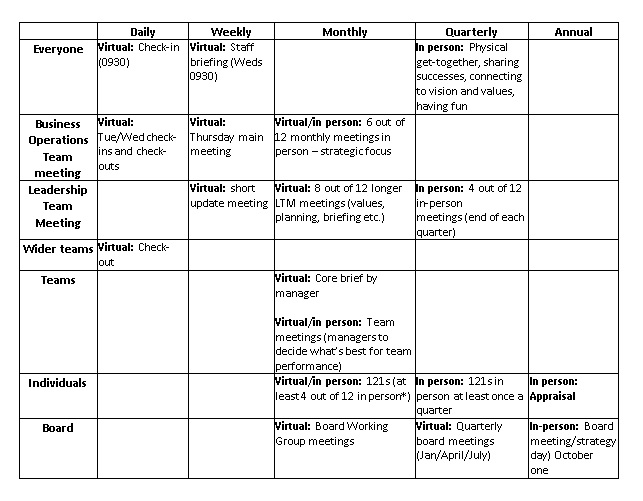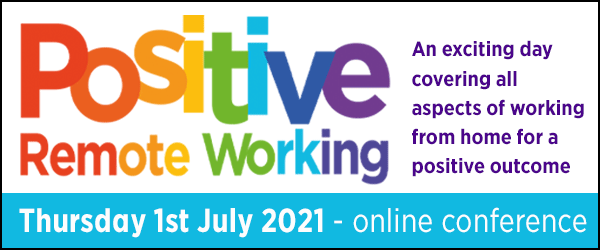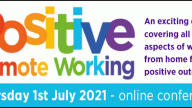Strategy and planning, Government and the Voluntary Sector, Management & leadership
Remote working vs in person?
Are you currently weighing up the pros and cons of a remote vs hybrid work setting? We've been through it, find out how we made our decision with Ben Wittenberg's helpful tips.
Like many other charities, we went through a short, sharp induction into the world of remote working last year. Despite having a few staff already working mainly from home, and two offices in London and Liverpool, doing EVERYTHING online took some adjusting to.
But now that we’re on the edge of being able to work together in person again, we’ve got a new set of challenges.
Do we return to everything being in-person and in the office again? Do we stay online and all work remotely? Or do we do a more complex mixture of the two, working together sometimes and not others – and if we do that, how, and who decides when that is?
There was a lot to consider
As with all big decisions at DSC, the place we started from was with our beneficiaries. Would us working remotely or in an office serve them best? The short answer is, we don’t think it makes a difference, at least for most of what we do. The work on our publications, Funds Online, our research activity and our online training and events have all been delivered really successfully while we’ve been working remotely. When we return to face-to-face training we’ll need to get trainers to the place they are training, but even pre-pandemic they were rarely in either of the main offices anyway.
What did our staff think?
All of them were managing well with working remotely. Lots of them were absolutely not missing travelling to work crammed on the tube or bus, but a lot of them were missing seeing each other. Some of them also thought that certain elements of their jobs could be easier working together, things like longer-term planning and creative thinking sessions, but nobody was keen on going back to being in the office full-time.
We also factored in the added complication that since last autumn, we no longer have an office in London. We were in the middle of an office move when the realities of the pandemic struck, so took the decision to keep our London-based staff working remotely for now, and make our Liverpool office our head office.
So with all that in mind, we set about planning what a hybrid working model might look like. We wanted to make sure we kept the flexibility of remote working for the most part, but re-introduced the face-to-face time in a way that was most impactful, in a way that was as fair and balanced as possible, and also had enough structure to it to allow staff to plan ahead, know when they might need childcare or have to make arrangements to travel.
Here’s what we came up with:
Without going through line-by-line, this gives us a few very important things.
- When we’re working remotely, everybody sees the rest of the organisation (at check-in) and everyone in their team (check-out) every day as a minimum. It’s usually short and sweet, but it makes a huge difference in connecting people and making them feel part of DSC, rather than shut away on their own beavering away for days on end.
- Everyone will get together in-person at least four times a year as the whole organisation. We used to do this twice a year anyway, so it’s not a huge change.
- Our main meetings will be a combination of virtual and in-person. Some will be fixed, but some, like team meetings will have a necessary level of flexibility. Our Research teams for example are relatively close to each other and our Liverpool office, so it’s easier for them to meet than our Publications team which is spread between Hereford and Dublin.
- Everyone will get face-to-face time with their line manager at least five times a year, in four 121s and at their annual appraisal.
How would meetings work?
The only other thing to add, is that we’re taking an approach of “virtual is virtual”, and “in-person is in-person”. If we’re holding an in-person meeting, we’ll schedule it and arrange it so that everyone who needs to be there is physically there, not with some there and some calling in on Teams or Zoom. So far, in all of our experience (stretching much further back than 2020), hybrid meetings like that are usually horrible and difficult to engage in fully. If we find a better way to do that we might review it, but for now, it’s all in-person or all online!
There are some financial implications of working this way, and there’ll be additional travel costs, but as an organisation we were already split-site before 2020 so we’re used to having to manage that. Also, in the short to medium term at least, we’re making savings not having a London office, which more than covers the additional travel for all-staff get-togethers and other meeting costs.
We’re in the process of implementing this now, and it’ll be fully operational by September (COVID restrictions willing!), but as with everything we do at DSC, we’ll review how it works and make any changes and tweaks as we need to.
There’ll be more on this kind of thing at our Positive Remote Working conference on Thursday 1 July 2021, but if you want more bespoke support on how to approach hybrid working for your organisation, contact our in-house team at [email protected].



